The gooseneck barnacle Pollicipes pollicipes is a very valuable marine resource on the coasts of Spain and Portugal. To maintain the sustainable exploitation of this species, periodical large-scale population assessments are essential. Because of the heterogeneous distribution of these populations in aggregates, together with the difficulties associated with sampling (i.e., access to rocky reefs, wave exposure, high tides, etc.), there is a lack of studies in this regard. In light of these constraints, the coverage, biomass, and available stock of gooseneck barnacle were first estimated using a novel semiquantitative method along a 215-km long coast at 10 fishing zones and three tidal levels. This study contributed to the first assessment of the distribution variability of gooseneck barnacle in the Cantabria region (N Spain), as the first step toward a long-term monitoring goal. The proposed method is based on a general coverage (GC) estimation, by means of (1) quantitative coverage measurements on quadrats (50 cm × 50 cm) located along vertical transects covering the intertidal bandwidth and corrected by tidal level bandwidths, (2) semiquantitative coverage estimates in larger areas, including 5 m on either side of the quadrats along the transect. Biomass samples were collected at each sampling point by scraping the 50 cm × 50 cm quadrat and fresh weight of the samples was measured. This method arrives at the biomass estimates by means of a power regression model for the coverage-biomass relationship. The population distribution pattern along the coast was also explored separately, by commonly used (1) quantitative coverage estimates in quadrats with no bandwidth correction (sample coverage, SC) and (2) semiquantitative estimates, as in the proposed method (transect coverage, TC), both of which included biomass sampling. Biomass and standing stocks values obtained using GC were lower and consumed less sampling time than those obtained by TC, and particularly SC. The results suggest that the proposed method might be suitable for the assessment of P. pollicipes populations in large coastal areas, as it potentially avoids stock overestimation by detecting the spatial distribution heterogeneity and reduces the sampling time.
How to translate text using browser tools
1 December 2017
Distribution Patterns of the Gooseneck Barnacle (Pollicipes pollicipes [Gmelin, 1789]) in the Cantabria Region (N Spain): Exploring Different Population Assessment Methods
Gorka Bidegain,
Xabier Guinda,
Araceli Puente,
José A. Juanes
ACCESS THE FULL ARTICLE

Journal of Shellfish Research
Vol. 36 • No. 3
December 2017
Vol. 36 • No. 3
December 2017
Coverage
gooseneck barnacle
Pollicipes pollicipes
sampling method
spatial distribution heterogeneity
stock assessment




